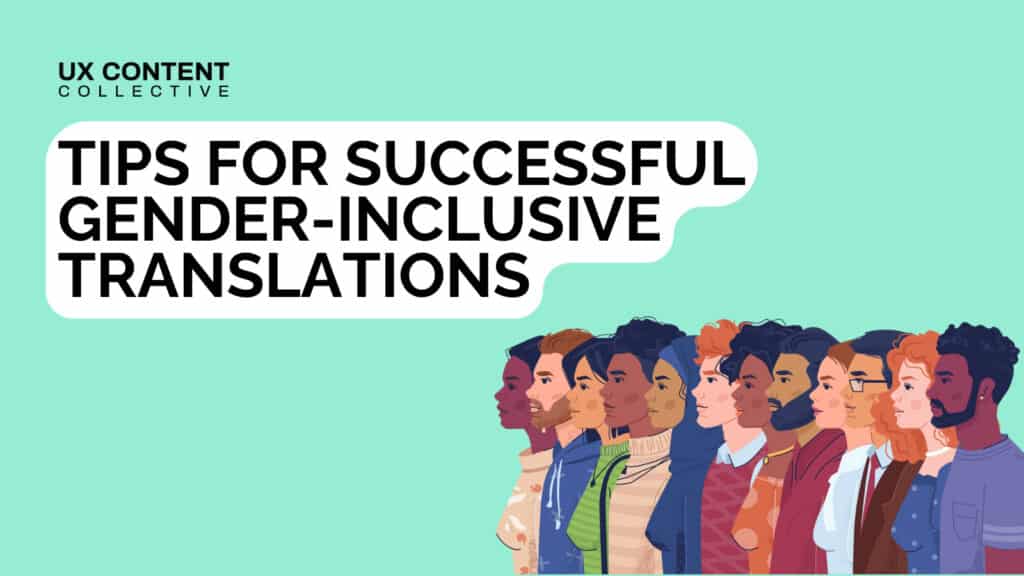

In our increasingly globalized world, international and multicultural teams come together more and more often to build the best content for their respective brands and organizations. But what implications does this diverse work structure have on inclusive language?
For those working in positions such as UX writer, UX designer, or translator who are curious to know how to improve their collaboration, this post is for you. I offer my five best tips for facilitating successful gender-inclusive translations from non-gendered into gendered languages.
Invite members with various roles into the conversation, such as marketers, UX writers, UX designers, translators, and sales managers. This way, you can give them an international overview to help them reflect on how practices in gender inclusion can vary dramatically depending on the type of languages (gendered or non-gendered) and regions at play.
Why is this important? If your UX writing team creates inclusive content, but your localization team doesn’t show gender sensitivity when translating your documents, it may create inconsistency that can be avoided with proper education. A lack of gender sensitivity can not only produce friction in internal projects but can also cause damage to the organization’s credibility.
A good tip is to write these elements in the internal communication language established by your organization. You can start from scratch or base your work on already-existing internal documents. Writing tailored guidelines for your organization will keep everyone on the same page and maintain consistency in your tone of voice (ToV) across languages, brand image, the messages you want to convey, and the way you address your target audience.
When localizing the guidelines into your target languages, keep in mind that the best inclusive UX writing practices for North American English may not apply to all prospective or target markets. For example, the use of exclamation points, capital letters, and informal tone can be seen as too intrusive by some readers. And while some gendered languages, like French, use the imperative as a way to avoid any mark of gender, this strategy doesn’t always work for other languages.
For instance, the imperative form in Hebrew remains gendered. This entails that your localization team or gender-inclusive language experts tweak and adapt your reference documents for the target language. Then, share these guides with all the departments of your organization and make sure your UX writing and design teams fully understand their scope.
Remember that gender inclusion can be a less-known topic for some of your audiences. While North Americans may be quite aware of gender inclusion, you shouldn’t assume that is also the case in your target languages. There can even be strong variations between one region and the other. For example, gender-inclusive language remains a heated debate in France, while Québec has been at the forefront of the practice for many years now. This means you’ll probably be required to write separate guides for each region, even if they technically speak the same language.
Once again, communication is KEY. Including translators and localization experts will allow you to consistently come up with top-notch content pieces. Some organizations even choose to combine their UX writers, designers, and localization specialists into one single team. Translators need as much contextual information as possible to localize your UI, so it can be a good idea to inform them about the thought process and goals behind your UX strategy ahead of the translation step. You can ensure that through regular meetings or directly in the tools and software you use, by providing screenshots and leaving space for comments. Having a continuous feedback loop might even improve the content, as an external pair of eyes can spot inconsistencies or surface a lack of clarity in your original text.
The length of the UI text is a good example of this aspect. French is estimated to be 20% longer than English, and some strategies of gender-inclusive language make the text even lengthier after translation. This can be a problem in the conception of visuals or ads that have a strict character limit. One solution is to ask the user how they want to be addressed at the very beginning of their online experience. Once again, this requires consistent communication within and across teams, as strictly monolingual speakers of non-gendered languages like English wouldn’t necessarily be aware of this issue, or of a potential solution.
Gender inclusion doesn’t exclusively lie in written language. It also manifests in images. What is the attitude of the people in the pictures? What do they wear? How do they engage with each other? This means that you need to be mindful of how symbolism varies across cultures. Not all languages and cultures perceive and portray gender roles in the same way.
What we have internalized as “masculine” and “feminine” colors in Western societies may not necessarily apply elsewhere. For instance, studies have shown that red and black are the colors that are most associated with masculinity by Chinese users, which is 3 times more than for the color blue Zhang 2015). So if your brand is selling gender-neutral clothing and wants to reach the Chinese market, you may need to rethink your color scheme.
Building and implementing a multilingual gender-inclusive strategy takes time, but you can start doing so with little or no budget. Take advantage of the competencies of any expert in your organization, rely on online resources, and promptly share knowledge across team members. You can maybe focus on the translation into one single gender-inclusive language to test out your strategy.
Once it proves to be effective and while your workforce grows, I would encourage you to estimate these human and financial needs accordingly for every language. Include each step of the process: research, hiring of specialists, internal sensitization campaigns, design, and localization. Doing so will allow you to conceive and deploy your gender-inclusive strategy without any surprises.
You’re now good to go! I hope that these five tips will support you in improving collaboration across your UX writing, UX design, and localization teams for flawless, impactful translations.
Do you have anything to add? Feel free to write to me at contact@laetitia-language-solutions.com with any feedback or reach out on LinkedIn to take this conversation further!
Laetitia Gathion is a French translator and inclusive language specialist from France, currently based in Copenhagen, Denmark. Connect with her on LinkedIn!

Explore our accessibility and localization training:
Get our weekly Dash newsletter packed with links, regular updates with resources, discounts, and more.
